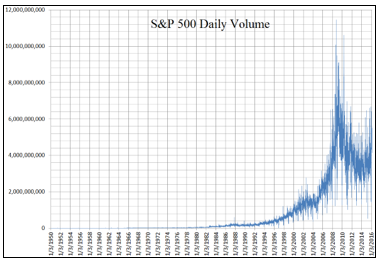 |
| By Karen Riccio |
You’ve probably heard references to the “algos” or algorithms causing big market movements.
That’s because when they kick in on any given day, for any particular reason, stocks can rage higher or lower on a dime.
It happens on a regular basis, so it’s impossible to ignore algos as they’re mostly to blame when extreme volatility rears its ugly head. At least they’re very simple to understand.
An algorithm is “a set of step-by-step procedures, or a set of rules to follow, to complete a specific task or solve a particular problem.”
In fact, we use algorithms in our everyday lives when we tie our shoes, do laundry or follow a recipe.
On the other hand, big banks, hedge funds and institutional investors use algorithms, usually mathematical, to make some 80% (depending on your source) of all trades in U.S. equities, and European and Asian markets.
Algorithms can trigger trades based on any factor a human directs it to, including technical indicators, price points, volume — even news events.
For example, an algorithm might be set to detect when the S&P 500 pushes through the 4,300 mark and to buy X amount of shares of ABC stock as soon as it does.
Processing real-time data at very high speeds is key to getting a jump start on the rest of the investing world and ultimately the lowest prices. That’s especially true when the same common denominators are used to trigger buys or sells.
That’s when we see mountains of money move, often exaggerating the market’s direction one way or another.
How HFT Has Changed the Game
The algos went crazy after the collective global shutdown in March 2020 due to the COVID-19 pandemic and subsequent plunge in markets.
The erratic, increased trading activity halted market-wide trading several times.
The sheer amount of data that’s generated, analyzed and processed, as well as the speed at which all of that happens and gives access to everything digital makes algorithm-based trading the beast that it is today.
The evolution of technology over the past couple of decades has put the fastest computers in the world in the hands of traders … giving them a distinct advantage over the rest of the investment world.
Although algorithm-based trading began in the 1970s, it really gained fame and momentum in the 1990s as technology gave rise to High Frequency Trading, or HFT for short.
HFT manages small but rapid-fire trade orders sent to the market at high speeds. By the turn of the 21st century, HFT trades had an execution time of several seconds. By 2010, it was down to milliseconds … and even microseconds.
Today, the best algorithms and computer networks can make several trades in just 64 millionths of a second. So, we’re talking about completing hundreds of thousands or millions of trades in a single hour.
Once the Securities and Exchange Commission authorized electronic exchanges in 1998, it forever changed the way stocks were bought and sold. In fact, that regulation basically solidified HFT a place in Wall Street’s future and sent the average number of shares traded per day through the roof in 2005, reaching a peak in 2009.

Click here to see full-sized image.
One way high-frequency traders profit is by monitoring and acting on price movements caused by large institutional trades.
For example, when a mutual fund sells a million shares of a stock, the price dips. HFTs buy on the dip, hoping to be able to sell the shares a few minutes later at the normal price. When a pension fund buys 2 million shares, the traders short the stock, hoping to close their position at a profit.
And while retail investors find out about important news and make decisions based on it just like everyone else, modern HFT software can analyze the Fed’s next move split-seconds after the news hits the Internet and make trades equally fast.
As you can well imagine — and have probably experienced firsthand — the scope of HFT can be disruptive. It certainly contributed its share of turmoil on the day now known as the 2010 Flash Crash.
You may recall May 6 of that year when the stock market experienced one of its most severe price drops in history: The Dow dropped by almost 9% from the open in a matter of minutes.
The crash was so rapid that the index tumbled 900 points in less than five minutes before recovering the bulk of its losses in the next 15 minutes of trading. The market lost more than a half trillion dollars in equity value that day, shaking what little faith nervous investors had in U.S. markets.
There’s a reason you haven’t heard as much about HFT ever since that disaster. But now, these algorithms have received an intelligent upgrade.
As you can imagine, as AI continues to get smarter in all other areas, it is becoming increasingly valuable in HFT.
The algorithms used for this lightning-fast trading can now use AI to help predict exact moments that leverage the predetermined buy and sell strategy for maximum gains. Thus, it’s taking the human element out of the equation even further. AI can adapt on the fly.
So far, this has drastically improved the performance of HFT. Though, it’s yet to be determined what this marriage will look like in years to come.
This is the argument for why investors of all sorts — even retail ones like us — need to stay abreast of AI’s impact on the investment landscape and how it will shape markets and investments for years to come. Of course, we’ll continue to track these trends in order to bring you the latest updates.
Until next time,
Karen
P.S. AI is obviously an important factor in how trading and investing will be done going forward. We’ve covered this in plenty recently. But it is also leading cutting-edge changes elsewhere … including your health. Check out this presentation about how it is already making a huge impact on healthcare.

